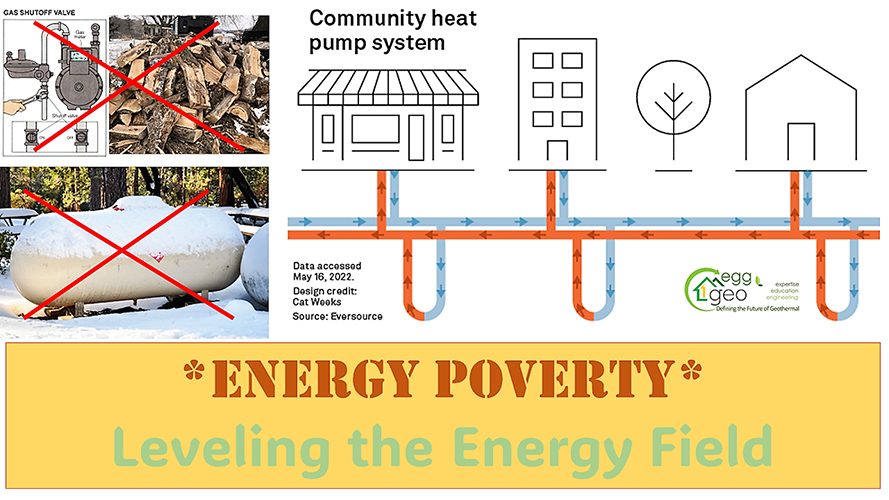Eradicating Energy Poverty: Thermal Energy Networks
Communities can use waste heat from commercial buildings and wastewater to provide space heating, domestic hot water, and even air conditioning.

Energy poverty occurs when energy bills represent a high percentage of consumers’ income or when they must reduce their household’s energy consumption to a degree that negatively impacts their health and well-being.
We noted this in 2009 when an employee struggled to afford a monthly electricity bill of about $450. Not only was it difficult to afford with a family on a limited income, but it was so expensive that it was impossible to get ahead without some sort of financial assistance. When we ran the numbers, it was clear that his energy bills could be reduced to below half of the present levels, making it much easier to meet his monthly budget within his current income.
More recently, we traveled to a village in western New York seeking an energy alternative to its propane deliveries. It has a population of about 3,000, and the average homeowner pays from $600 to $800 per month for propane to keep warm in the winter.
While a suitable alternative for these homeowners might be wood-burning fireplaces and stoves, few have access to the six to 10 cords of wood needed to keep a home warm throughout the winter. A standard full cord of wood has a volume of 128 cubic feet, measured as a pile 8 feet long, 4 feet high and 4 feet wide. A full cord can weigh up to 5,000 pounds and costs about $700.
When you consider how much a similar customer spends per therm on natural gas versus propane or firewood, it is easy to see why the subsidies make the cost of natural gas significantly lower than burning propane and firewood (about half the cost nationwide as of September 2023).
The problem is many small communities do not have access to natural gas. The bigger problem is that natural gas is methane, a potent greenhouse gas, and contributes significantly to greenhouse gas emissions.
Sharing Thermal Energy
Around the country and the world, natural gas consumption is being rolled back in favor of a new distributed energy resource: thermal energy networks (TENs).
TENs are utility-scale thermal energy infrastructure projects connecting multiple buildings into a shared network with thermal energy sources such as geothermal boreholes, surface water and wastewater.
A delicate balance is at work here. Most of the world has access to electricity but limited electricity. As we know from reports of rotating blackouts on the hottest of days of summer and the coldest of days in the winter, electrical infrastructure is taxed heavily when using electric heat pump technology to heat, cool and provide domestic hot water (DHW) needs for a home or commercial building.
As natural gas, propane, wood and oil do not necessarily stress the electric grid, they are seen by many as the only choice to provide heating and DHW. We need technology that can provide heating and DHW from a heat pump without causing a dramatic spike in the electric grid, as we have seen with air-source heat pumps on the coldest days.
Heat pump efficiency declines as the source temperature outside declines, so the colder the day, the more the energy spike in electrical consumption.
This is not true with geothermal heat pumps that are engineered and installed properly. With a TEN configuration, the first cost of geothermal boreholes, exchangers and other variations to tap into the earth’s energy, the cost of the geothermal exchanger, is normalized as a utility, like drinking water, sewer and natural gas. With a TEN, the customer can hook up a geothermal heat pump in much the same way a furnace or boiler is connected to a natural gas service.
Many utilities installing TENs have received direction and permission to fund the cost of the new electric domestic hot water tanks, electric induction stoves and geothermal heat pumps. Even with these costs involved in designing and constructing a new energy network, the energy cost on these networks is dramatically reduced because of community thermal energy diversity.
Delivering Waste Heat
Even on the coldest winter day, a geothermal exchanger may be designed to handle the thermal loads needed for the buildings it services. The ingenious part of a community system is that most mixed-use communities have a cooling-dominant load, even in the middle of winter.
The energy normally exhausted through cooling towers on commercial buildings is redirected to apartments and single-family homes that need the energy the most in the middle of the winter.
In this way, the energy cost for heating homes and spaces with previously high energy bills for propane and the like is dramatically reduced. The energy is already available and simply needs to be piped from buildings with an excess of waste heat to those that can use it.
A good analogy of this would be the adage we have all heard around the dinner table: “Be sure and eat all your food; you know children are starving in Africa.” Even at the early age of five or six, I can remember thinking how unreasonable it was. Many of us asked our parents, “Can I put the food in an envelope and send it to them?”
That is, of course, ridiculous. We do not (necessarily) have a pipeline to get the food waste from our tables to those who need it. The same thing is true with energy; most commercial buildings have abundant waste energy pumped into the ambient air through cooling towers and air-cooled condensers.
What we are lacking is a delivery mechanism. That is what a TEN does.
This delivery mechanism costs money for design, installation and maintenance. Those first costs are a one-time investment, allowing us to turn off the boilers and furnaces in most of our residential and light commercial buildings. We use the abundant waste heat to supply energy to geothermal heat pumps that deliver high-quality thermal energy to our single-family homes, apartment buildings and any other energy users that presently combust fuel for heating and DHW.
TENs and Decarbonization
Whether our cities and communities are equipped with a natural gas distribution mechanism, TENs are the perfect solution to eliminate natural gas consumption for heating and DHW needs. They are the means to normalize energy costs to a much more affordable level for all customers connected to them.
The benefits are amazing:
Jobs: Transferability for gas utility workers and pipefitters
Cost: Lower energy bills
Safe and reliable: Noncombustible and consistent energy flow
Equity: Renewable thermal energy delivered to all customers
Health: Improved indoor and outdoor air quality (no combustion in the building)
Grid: Flattens the peak loads on the electricity grid
Climate: A major reduction in carbon emissions from buildings
The Inflation Reduction Act of 2022 provides a path to work toward reducing energy poverty and eventually ending it altogether. Every single person is entitled to health and comfort; there should never be a question of whether they can heat their home in the winter or buy groceries.
Implementing TENs is not only beneficial on a fiscal level, but on a human level as well. At the end of the day, sustainable energy is energy focused on sustaining this planet — our home. Prioritizing the health and wellness of people, as well as the environment, is the very core of the green energy movement.
This is the answer to decarbonizing our buildings. Get behind thermal energy networks in your community, your city, your state and federally. Some states already have legislation opening thermal energy sharing in communities; many more are in the process of establishing programs right now.
Find out what your community is doing and make sure your legislators know how fantastic TENs are toward reducing energy poverty in America and beyond.
Are you curious about what will work for your application? Check with the International Ground Source Heat Pump Association (www.igshpa.okstate.edu), the Geothermal Exchange Organization (www.geoexchange.org), or email us at jegg@egggeo.com.
Mimi Egg is a social media marketing professional, writer and media technical consultant for Egg Geo (www.egggeo.com). She may be reached at mimieggshell@gmail.com.
Jay Egg is a geothermal consultant, writer and owner of Egg Geo. He has co-authored two McGraw-Hill textbooks focused on geothermal HVAC technologies. He can be reached at jegg@egggeo.com.





